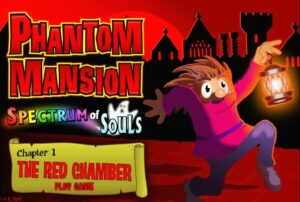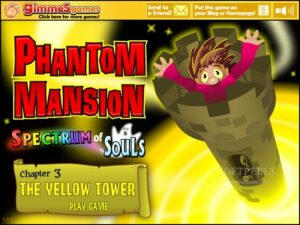IT IS FINALLY HERE! THE FINISHED PRODUCT! (apart from the final pictures for rooms Blue and onwards, but don’t worry about that). I am deeply sorry for the long delay in posting the finished version, but I had certain… obligations… to tend to. Namely GCSE’s. Don’t fret though. You can read to your heart’s content now!
You may remember this from your childhood, and decided to re-play the game for old-times sake. But, like always, you get confused about a particular level that presents itself with no easy way out. What do you do? Fortune has smiled upon you, lost Hector, as you have stumbled across the right place for you to quench your thirst for knowledge.
Unfortunately, due to certain…restrictions…I will not be able to post a detailed walk-through about every single level about every single room in the series. I will, however, do my best to provide you with helpful hints and tips, and information on what every game aspect involves. Let us proceed across the spectrum!
The Red Chamber:

“Hector is trapped in a huge, cursed mansion. To escape the Red Chamber, and break Red Death’s curse, Hector must pass all the puzzle and collect all the trapped souls. After Hector finishes the last puzzle room, he is granted entry to the Red Chamber Shrine. There he finds one of the masks. After collecting it he continues on to the The Orange Library”
The first of the series, the one to kick it all off. So of course this would be the room to introduce the most game aspects. I will not list them in order of appearance…
Hector – the playable character. The admirable hero who stumbled across, and gets trapped in, the spectrum of souls, where he has to collect all the trapped souls to break the red death’s curse and escape the red chamber.
Zombies – the traditional game bad-guy, zombies would inevitably pop up in a haunted mansion. Even though they are big no-no to walk into, they are easy to avoid; Hector can outrun them, and since zombies can not push iron blocks or double boxes, you can trap them.
Skeletons – essentially the same as the zombie, but with different aesthetics and sounds. The one difference between the two is that skeletons move vertically while zombies move horizontally.
Doors – separate different rooms within levels, and can either be locked or unlocked. Once opened, however, they cannot be closed.
Keys – used to unlock locked doors. Hector can carry multiple types of keys at once. There are four types of keys; circle, cross, triangle, square. These keys unlock the corresponding door type. For example, a square key can only unlock a square door.
Boxes – these are push-able items used to block enemies, build bridges and hold switches down. There are two types of boxes; wooden boxes can be pushed by enemies, whereas metal boxes cannot. This feature can be used to trap enemies in one-tile spaces.
Souls – all souls in the level are needed for Hector to unlock the exit.
Cracked tiles – when Hector steps on these, the floor breaks and Hector cannot step back onto the tile. This can create one way systems. There are two types of cracked floor. Small cracks can be stepped on twice, whereas big cracks can only be stepped on once before the tile breaks. Enemies can walk on cracked tiles without affecting them, and boxes can sit on them as well.
Stairs – a set of vertical tiles that allow Hector to walk up and down between two different levels. Boxes and enemies can also move up and down them.
Gaps – a gap in a rail, allowing hector to move down a level but not back up. Boxes cannot be pushed down them.
The Void – the red swirly thing under the tiles. If Hector falls in, he will instantly fail. Boxes can be pushed into the void to create bridges, enabling you to safely cross to another segment of the level.
The Orange Library:

Hector continues his adventure though the mansion after he went though the The Red Chamber next he is in the Orange Library in order to get though the Orange Library he must solve more harder and more challenging puzzles. After he finishes all the challenging puzzles he is granted to the Orange Library’s Shrine where he finds another mask and after he collects it he goes further up to the The Yellow Tower where more harder and tons of puzzles await.
The second room of the series. Only two new aspects are introduced in this game, but since they are important, they need to be discussed.
Teleport – these blue doors warp whatever enters them to another location. This allows Hector to warp to other areas of the level that have no other access. Boxes can also be pushed through these portals. This enables switches to be kept on in other rooms. As well as this, since Hector steps out of the portal one tile in front of it, he will fall into the void if a tile is missing in front of the portal. This can be overcome by pushing boxes in first, which will fall into the void before you step into the teleporter, creating a bridge.
Fake walls – these are walls in which Hector, enemies and boxes can walk through. They are similar in appearance to regular walls, but with one difference. the centre square in the wall of a ‘fake’ wall is larger. By studying all walls, you will be able to tell which wall is real and which is not.
The Yellow Tower:

The third room in the series. The wiki I quoted the plot-line from for the previous two games seemed to have given up, and could only give me this:
The third game in the Spectrum of Souls series.
So I guess I’ll be giving you the plot synopsis myself… After escaping the Orange Library, Hector finds himself in the yellow tower, which he needs to climb and escape from by finding all the souls in all the rooms and then collecting the Yellow mask. He then goes on to escape. Only to find himself in the Green Gallery.
Only one new aspect has been introduced in this game, but it is an important one, and is split into two parts.
Cursed Tiles – this is resembled by red devil faces on the tile that is cursed. One step on this tile will kill Hector, so make sure you do not stray on it. In this way, cursed tiles are like the void, except that boxes can be pushed along it, enemies can walk across it and it can be cured, enabling Hector to walk across it.
Cross – the cross is needed to be collected in order to cure the cursed tiles. It is gold in colour, and roughly the same size and texture as a key. The cured tiles resemble a white angel with a halo, meaning that they are safe to walk across.
Bridges – these are simply tiles that connect one raised level with another. They enable Hector and enemies to walk underneath it as well as over it. These are not technically a new feature, as they were briefly encountered on the last level of the Red Chamber.
The Green Gallery:

The fourth room in the series. It seems that the wikia site has finally given up all hopes, so there is absolutely no quote I can give you from now on. Let me just jump into the new features, as the plot is essentially the same….
There is only one new aspect found in the Green Gallery. It is again very important.
The Magic Lamp – this is a device which allows Hector to see the invisible bridges across the pit of despair. These invisible bridges can still be crossed without the lamp, but the magic lamp enables you to see one step ahead or behind you, showing you if there is a bend in the path of tiles. This needs to be coupled with care, however, as if Hector travels too fast, your reaction speed will not be quick enough to notice the sudden bend in the track and change course. The bridge, when showed up, looks like a darkened version of the floors main tiles. Enemies can also cross these bridges, and so can boxes.
The Blue Ballroom:
The fifth room in the series. Three new aspects to notice, two of which needs to be delved into really thoroughly.
Healing Potion – these potions are blue in appearance with a red cross on it. This potion simply removes all effects of the harmful potions applied to Hector previously.
Hyper Potion – these potions are red in appearance, and has a white skull and crossbones silhouette on it. They cause Hector to constantly move in the direction the arrow key was pressed until it comes in contact with an obstruction. Since you can only stop when you meet an obstruction, it can be nigh on impossible to enter new areas. This is why it is extremely important to plan ahead most of the time before you pick up the potion, and give yourself a way to the exit.
Confused Potion – these potions are pink in appearance, and has a white 4-directional compass silhouette on it. They cause Hector to move in the opposite direction of the arrow key pressed. This can cause serious confusion, just as the name of the potion indicates. There is no real problem with this potion, just that it causes serious rage when you accidentally press the wrong key and fall into the void. It is also possible to stack the two harmful potions, creating double confusion on Hector.
The Indigo Dungeon:
The sixth room in the series. The room where Hop-Frog the Dwarf makes his debut. Because of the intricate aspects Hop-Frog has, This section of this post will have to be dealt with in great detail.
Hop-Frog – the troublesome dwarf found within levels in the Indigo Dungeon. Hop-Frog is attracted to gold keys, but only to ones in which you carry around. He will try to avoid you if you do not carry a key, but will run towards you when you pick one up. Hop-Frog will run in the opposite direction from you when he is trying to avoid you. Because of this, Hop-Frog can be manipulated and controlled so as to run over switches that are inaccessible by Hector. This game feature can be used to unlock doors and make souls appear. This game aspect is especially seen in ‘Remote Control’. However, you can only take your key(s) away from Hop-Frog once. This results in a second fist fight with the dwarf – the first of which was observer when Hop-Frog first took your key(s). The result of this fight results in Hop-Frog disappearing from the level, so he cannot be used anymore. Hop-Frog can only be captured if he is trapped within a one tile space. This can occur either naturally in the level, or you will have to create this one tile space, either by breaking cracked floor tiles or by maneuvering boxes, as Hop-Frog is too week to push any boxes.
The Violet Vault:
The seventh room in the series. Only one new feature is introduced here, and this is a new enemy for you to manipulate.
Ghost – the final enemy to be introduced to the game. The movement pattern of the ghosts is very interesting. Whenever they come in contact with a wall, a ghost will turn 90 degrees clockwise or anticlockwise, and this is determined on what type of ghost this is. The ghost comes in two variations: red and blue. The red ghosts turn right whereas the blue ghosts turn left. This can create a vast complicated mesh of enemies when they all turn in different directions at different times. Like Hop-Frog, ghosts can be manipulated to hit switches that hector cannot access. Since the ghosts can float, they can travel over the pit of despair to reach switches on the other side. However, ghosts are too light to push boxes, so Hector can push boxes into places in order to control where a ghost can travel to get it to push a switch.
The Black Sanctum:
The final room in the series. All the masks gathered from all previous rooms are thrown into the eternal flame, which will banish the Red Death from the mansion. In this room, all game aspects from across all rooms are used in different levels. This increases the difficulty of even level one tenfold. Because of this, it is advised to play all games in advanced to get used to the different aspects. For those of you who have not done this, or for those who feel they need to touch up on their skills, 7 rooms are located on the bottom floor of the level select room, all open. These levels contain one level from each previous room – resulting in the number 7 – and are used for the soul purpose that they are best for homing your skills further.
FAQ’s:
Unfortunately, I have not been asked any questions relating to this game, most likely because nobody is interested in it….. if you are interested however, don’t be afraid to contact me by following the instructions found in the contact us section. I will be looking forward to doing another – hopefully shorter – hints and tips post in the future. Preferably next week (sorry for this long delay).






